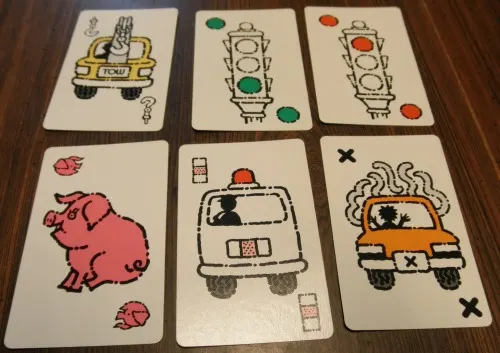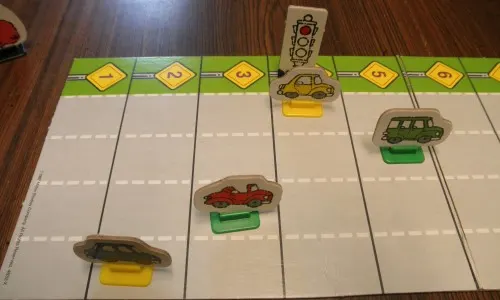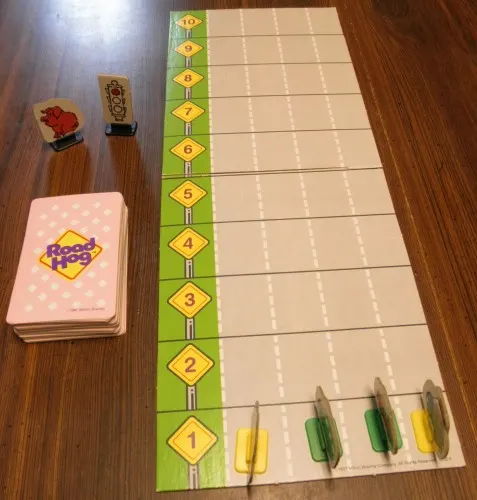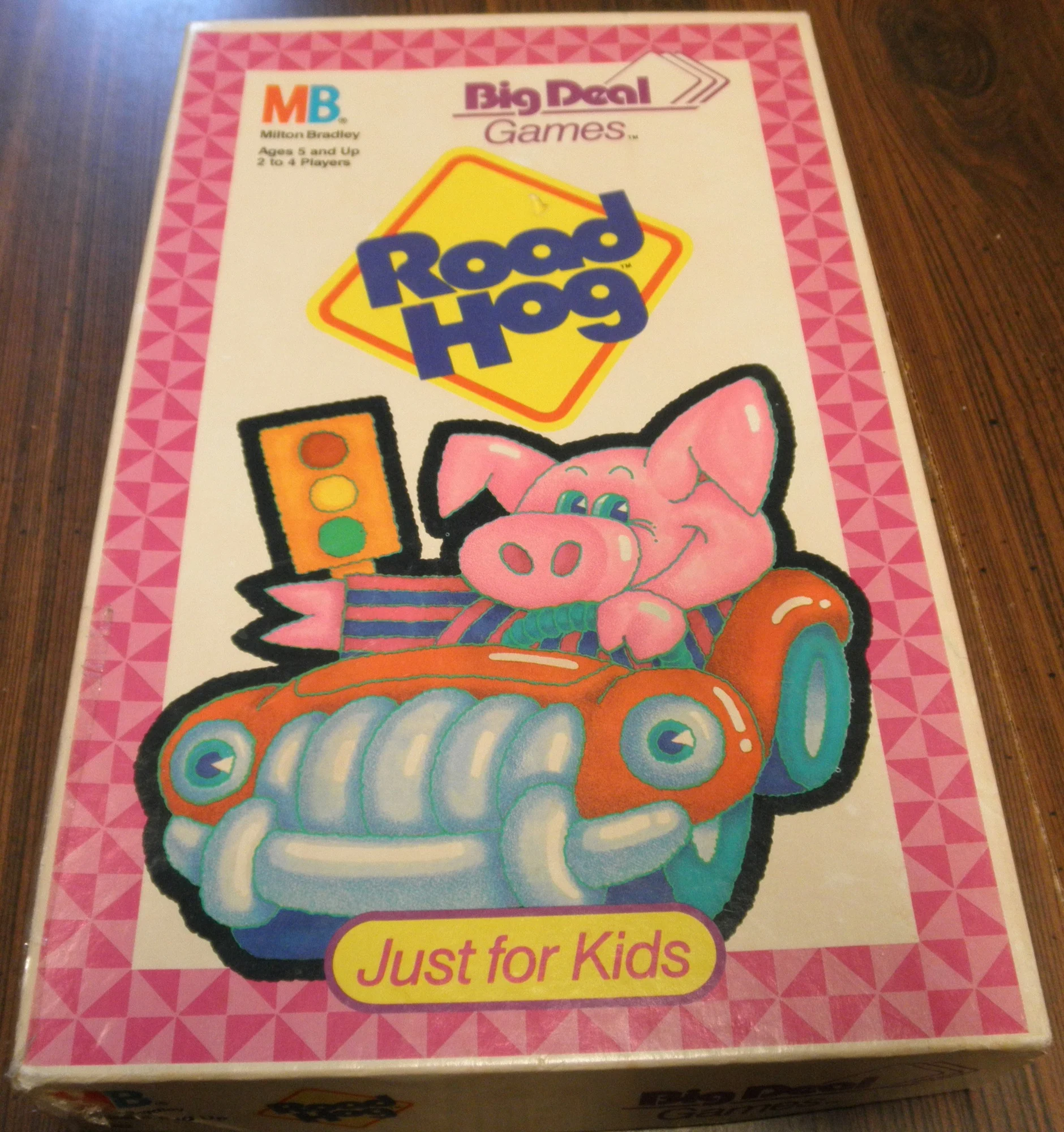How to Play Road Hog
In Road Hog the object of the game is to be the first person to reach the finish line.
The game begins with each player choosing a car token and placing it on the start line. Each player is dealt five cards. Each player has a play pile and there is a discard pile.
On a player’s turn they begin by playing a card on either their own play pile, one of their opponent’s play piles or on the discard pile. The player follows the card’s corresponding action. The player then either takes the top card from the draw pile or the discard pile. If the player cannot play a card, they may either discard a card and draw the top card from the draw pile or they can discard their whole hand and draw five new cards.
The game includes the following cards:

Number Cards: Number cards are used to move your car playing piece forward one space on the gameboard. A number card can be played on any other number card that either matches the number or color; any pig, ambulance, or tow truck card, or if it is the first card in the play pile.
Breakdown Cards: Breakdown cards are played on other player’s piles. If the breakdown card matches the color of the top card of another player’s pile, the card stops that player from playing until they are able to play a tow truck card.
Tow Truck Cards: Tow truck cards are played on top of broke down cars in order to be able move the car in future turns.
Pig Cards: Pig cards make the player who they are played on skip a turn. Pig cards can be played on any card except for another pig card or a breakdown card.
Red Light Cards: When played the stop light token is placed on the gameboard on any numbered row chosen by the player who played the card. After being played the card is placed in the discard pile.
Green Light Cards: When played, the card removes the stop light token from the gameboard. The card is then placed in the discard pile.
Ambulance Cards: Automatically moves your playing piece one space forward even through red lights. Can be played on any card other than a breakdown card.
During the game a red light token may be placed on the gameboard. If a player has already passed the red light token, it does not affect the player at all. Players behind the red light token can move up to the line before the red light token. Players may not pass beyond the red light token though unless they play an ambulance card. In order to remove the red light token a player needs to play a green light card.

Whichever player is the first to reach the finish line is the winner.
My Thoughts on Road Hog
When I think of Road Hog the only word that comes to my mind is BORING. The game is perfectly playable. There aren’t any rules that break the game. Unfortunately there is essentially no suspense or strategy in the entire game. Therefore in my opinion, it just isn’t really worth playing
Road Hog likes to praise itself as being a mixture of a board game with a card game. While that is technically true, the game doesn’t do a very good at either in my opinion.
The board game portion is almost pointless since the only time the gameboard actually comes into play is when a red light card is played. The gameboard is essentially just used as a prop to show how close every player is to winning the game.
The card portion of the game is also not very good. There was potential but none of it shows up in the actual game. The card portion of the game is essentially Uno (matching colors and numbers) with some special cards added in. Most of the special cards don’t really even add a whole lot to the game.
The breakdown cards are essentially stall cards that extend the game. If the player already has a tow truck card, the player will just lose a turn. If you don’t have a tow truck card, your best option is to keep discarding your entire hand until you are able to find a tow truck card. This is the best option since there are only a few things you can actually do if a breakdown card has been played against you.
The pig cards are actually even more pointless in my opinion. They are the typical lose a turn card. Due to how the rules are set up, there is actually a reason you may want to play them against yourself to skip a turn. The reason you might want to do that would be to take advantage of the fact that pretty much any card can be played on top of a pig card. If you have a number card or a set of number cards that work well with each other you may want to play a pig card on yourself if you are unable to play the number cards right now. After you play a pig card you are able to play any other card on top of it, so by wasting a turn with the pig card you essentially clear your own pile allowing you to play the number cards in your hand that you would have otherwise not been able to play.
The red and green light cards had potential to add something to the game, but in my experience they don’t really do much. I am guessing that they were added to the game in order to add a gameplay mechanic to help players either catch up or to extend their leads. I would say that they were more of a hindrance than anything else since they wasted spots in my hand. In the game I played, the red stop light was played a couple times but it rarely had any effect. Either players already had a green card to play or they wouldn’t have been able to move that turn anyway.
The game could have been better if there was more strategy to it. The only real strategy in the game is choosing when to play breakdown or pig cards against opponents and choosing when and where to play a red light card. The main reason the game has no strategy is that on most turns there will be either an obvious move that everyone would make or there is only one choice. The lack of strategy makes Road Hog a game that relies heavily on the luck of the draw. If you don’t get the right cards, you won’t win the game.
The components are nothing special. The cardboard pieces and the cards are of a pretty typical cardstock. They should last a decent amount of time even though the copy of the game I acquired already had a lot of wear. The artwork is just plain boring in my opinion.
Should You Buy Road Hog?
Road Hog is a perfectly functional game that doesn’t have any glaring issues with the rules or other factors that break the game. I personally thought Road Hog was a boring game though. The game has little strategy and the strategy that the game tries to add fails to really add anything to the game. I really can’t recommend Road Hog unless you have small children. Adults will just be bored playing the game. If you have smaller children though you might get some enjoyment out of the game since it is a pretty easy game to play.

Road Hog
Year: 1987
Publisher: Milton Bradley
Designer: NA
Genres: Card, Family
Ages: 5+
Number of Players: 2-4
Length of Game: 20 minutes
Difficulty: Light
Strategy: Light
Luck: Light-Moderate
Components: 32 number cards, 8 breakdown cards, 7 tow truck cards, 3 slowpoke pig cards, 4 red light cards, 4 green light cards, 2 ambulance cards, hazard highway gameboard, 4 car tokens, 1 red light token, 1 slowpoke pig token, 6 plastic token stands, instructions
Where to Purchase: Amazon, eBay
Any purchases made through these links (including other products) help keep Geeky Hobbies running. Thank you for your support.
Pros:
- Kids may enjoy the game.
- The game is not broken.
Cons:
- The game is boring.
- The game has little to no strategy.
- The artwork is bland.
Rating: 2/5

